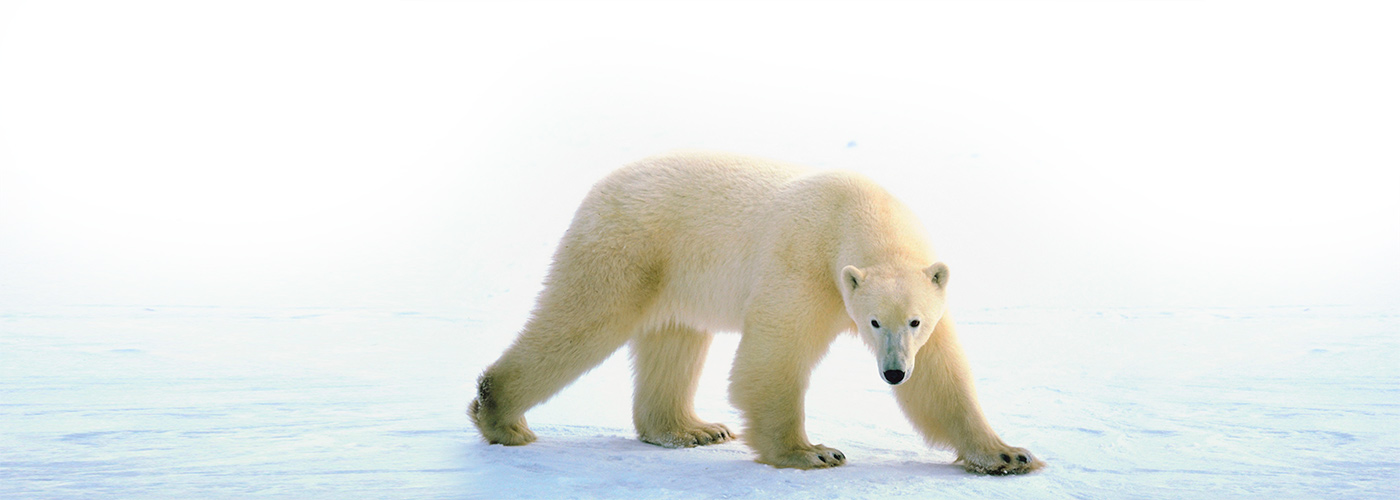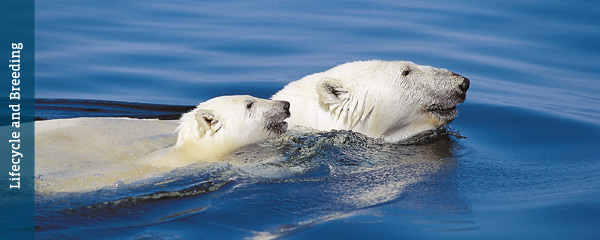Anatomy and Physiology
Polar bears are a miracle of evolution. Their bodies are stream-lined machines designed for Arctic survival.

Ears
 A polar bear’s ears are short and rounded to help prevent water entering the ear canal which could then freeze and damage their ear drums. Their hearing level is comparable to a human’s.
A polar bear’s ears are short and rounded to help prevent water entering the ear canal which could then freeze and damage their ear drums. Their hearing level is comparable to a human’s.

Eyes
 A polar bear’s eyes are dark, and are covered with a nictitating membrane, which protects their eyes from the bright sunlight as it reflects off of the snow. They can see some colour, and their vision is comparable to a human’s.
A polar bear’s eyes are dark, and are covered with a nictitating membrane, which protects their eyes from the bright sunlight as it reflects off of the snow. They can see some colour, and their vision is comparable to a human’s.

Teeth
 Polar bears have 42 teeth; large, jagged canine teeth to rip through the tough hides and flesh of their prey, and grinding surfaces in their cheek teeth.
Polar bears have 42 teeth; large, jagged canine teeth to rip through the tough hides and flesh of their prey, and grinding surfaces in their cheek teeth.

Stomach
Polar bears have adapted to be able to process a diet so high in fat that most animals would not be able to survive eating the same. Younger, growing bears will eat both seal blubber and meat (for protein); while adult bears often only eat the blubber.

Sexual Dimorphism
Polar bears exhibit drastic but limited sexual dimorphism. Meaning that though the males (boars) are 2 to 3 times larger than the females (sows), there are no other physical characteristics (i.e. ornamentation) that differentiate the sexes.

Tail
All bears have short tails, but a polar bear’s tail is even shorter (like most of its appendages), as it helps to reduce heat loss.

Blubber
Polar bears have a thick layer of blubber (fat) that can be up to 4 inches thick, and can represent up to 50% of a polar bear’s weight. It is used as insulation, working in conjunction with the bear’s fur to help keep it warm, and helps keep the bear afloat while swimming.
Another use is as energy storage, especially important in the summer when seal hunting becomes increasingly difficult. When using fat for energy oxygen combines with the fat in the process to release carbon dioxide and metabolic water (similar to a camel). This is crucial for survival in a polar desert, where in the winter months fresh water may be scarce.

Stature
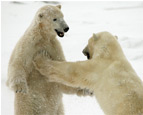 Polar bears have a narrower, longer build than other bear species, and you can see this especially in their face and elongated neck. They have low, sloping shoulders due to their front legs being shorter than their hind legs. This makes reaching down into seal’s breathing holes easier, as they can be 6 feet deep.
Polar bears have a narrower, longer build than other bear species, and you can see this especially in their face and elongated neck. They have low, sloping shoulders due to their front legs being shorter than their hind legs. This makes reaching down into seal’s breathing holes easier, as they can be 6 feet deep.

Paws
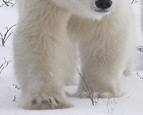 A polar bear’s feet are disproportionally large in comparison to its body. This is because they act as built-in ‘snowshoes’, allowing the bear to spread its weight over a larger surface area and easily cross soft snow drifts.
A polar bear’s feet are disproportionally large in comparison to its body. This is because they act as built-in ‘snowshoes’, allowing the bear to spread its weight over a larger surface area and easily cross soft snow drifts.
The pads of their feet are covered with ‘papillae’ – otherwise known as ‘dermal bumps’ – which stop their feet from slipping on Arctic ice, along with the thick fur between the pads. Their toes are partially webbed to allow them to swim with ease.

Claws
 Long, non-retractable claws provide extra traction, and are used for grasping prey.
Long, non-retractable claws provide extra traction, and are used for grasping prey.

Skin and Fur
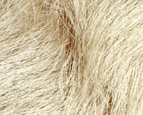 A polar bear’s best resource in keeping warm on the tundra is their luxurious fur coat. Comprised of two layers – long, silky outer guard hairs, and thick, dense undercoat – a polar bear’s full winter coat will have an average of 10,000 hairs per square inch! The outer guard hairs are hollow for increased insulation, and the coat is also waterproof, enabling the bear to easily shake off water after a dip.
A polar bear’s best resource in keeping warm on the tundra is their luxurious fur coat. Comprised of two layers – long, silky outer guard hairs, and thick, dense undercoat – a polar bear’s full winter coat will have an average of 10,000 hairs per square inch! The outer guard hairs are hollow for increased insulation, and the coat is also waterproof, enabling the bear to easily shake off water after a dip.
The core of each hair shaft being hollow, transparent, and pigment-free, allows it to scatter and reflect light, which gives the polar bear its white appearance.
Polar bears molt from spring to late summer, shedding the fur that has accumulated oil from their prey, making the bears appear yellow. It is after this period, when the sun is at its peak, that polar bears look their whitest.
Underneath their fur a polar bear’s skin is black, which helps absorb sunlight for warmth.
Their coat and skin are so effective at keeping the bears warm that they actually struggle during the short Arctic summers, and can often be seen digging into the permafrost, or lying flat on any remaining patches of ice.

Nose and Snout
 The polar bear’s nose enables it to smell a seal’s breathing hole from 1.6 kilometres away, and through 1 metre of snow cover; a seal on open ice can be sniffed out from up to a distance of 32 kilometres. It’s also somewhat ‘periscopic’ – a network of fine muscles mean that polar bears can literally follow their nose as it will bend towards the source of the smell.
The polar bear’s nose enables it to smell a seal’s breathing hole from 1.6 kilometres away, and through 1 metre of snow cover; a seal on open ice can be sniffed out from up to a distance of 32 kilometres. It’s also somewhat ‘periscopic’ – a network of fine muscles mean that polar bears can literally follow their nose as it will bend towards the source of the smell.
A long snout acts as a heat and moisture exchanger; cold, dry air is warmed and moistened before reaching the lungs.

Sixth Sense – Direction
No one is completely sure what’s behind the polar bear’s incredible sense of direction. With the Arctic ice constantly changing, and having a night that lasts up to six months at a time, polar bears seem to be able to navigate extraordinarily well; even swimming to shore from a hundred kilometres out. Some scientists think that polar bears have an internal compass that uses the earth’s magnetic field to guide them.
